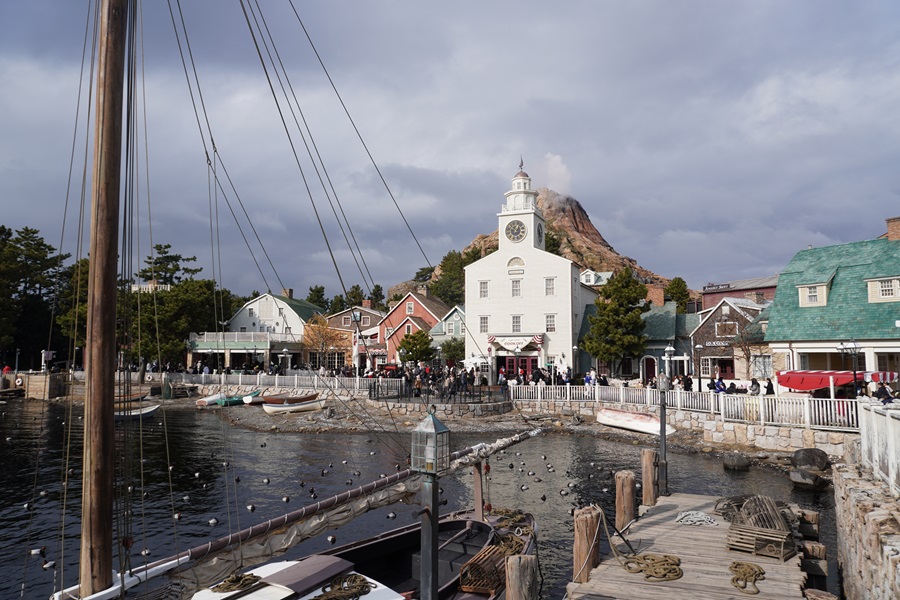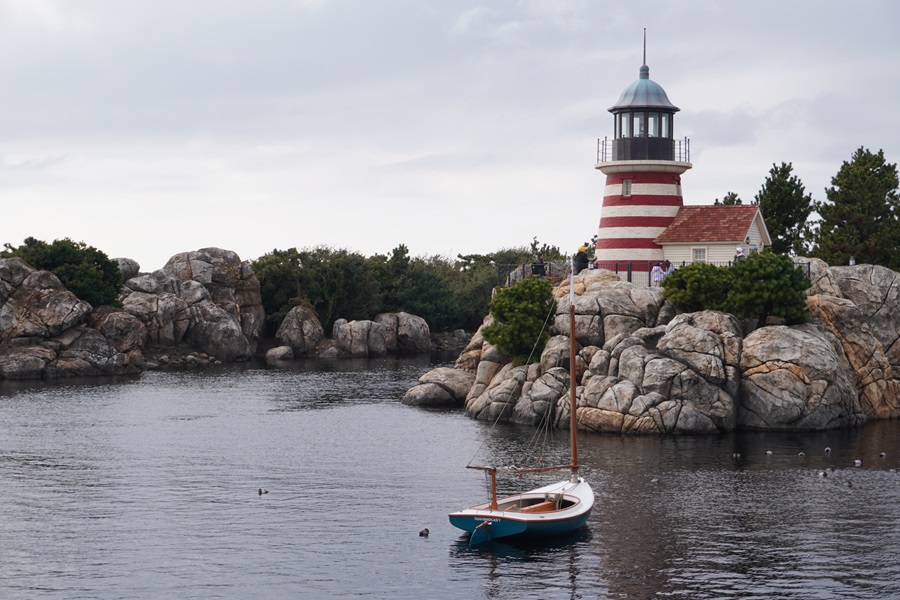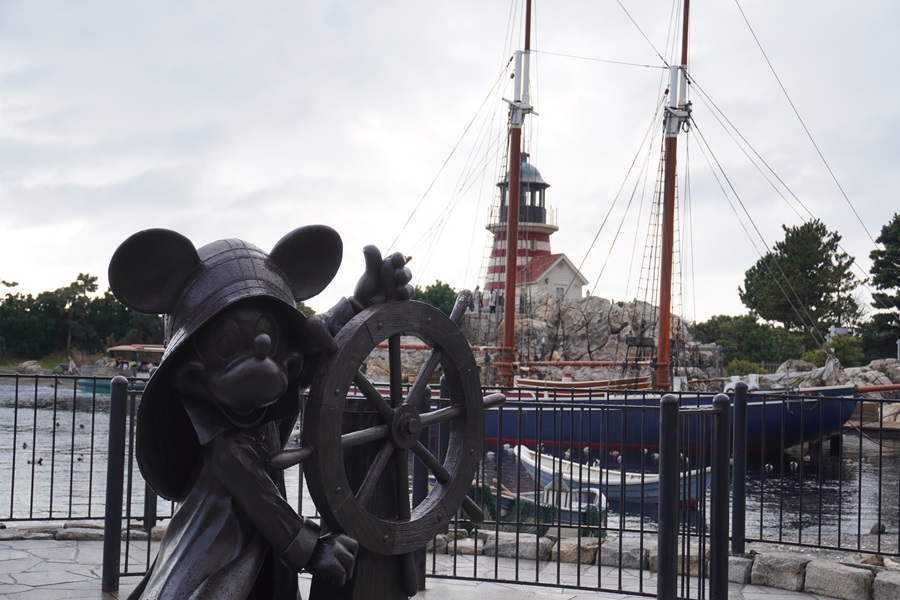Tourists flock around the shoreline, snapping photographs of rowboats and lobster traps. “Youkoso, Keipukoddo e,” a restaurant worker shouts: Welcome to Cape Cod. But I’m not on Cape Cod: I’m in Urayasu, Japan, 6,753 miles from home.
Tokyo DisneySea, which first opened in 2001, 18 years after Tokyo Disneyland was built, is arranged around a roughly 25-acre artificial bay just east of the city. It is the seventh most visited theme park in the world, according to a 2023 study by AECOM, the architecture and engineering consulting firm. California resident Chick Russell, who was the park’s head designer, was the writer and producer for its Italy, New York, and Cape Cod “waterfronts.”

Russell’s simulacrum, a cluster of colorful wooden buildings with white picket fences, is nestled around a shallow harbor where sailboats and dinghies with names like Squibnocket and Cats Paw bob among a flock of ducks — common pochards, I think — that have landed in Japan for the winter. The centerpiece, a tall white building with a gold-on-black clock facing the water from above its third-floor windows, looks vaguely like the First United Methodist Church in Chatham.
The lighthouse is less convincing: it’s a squat little thing with rings like a candy cane, and it watches the bay from a steep pile of rocks more characteristic of Maine than Massachusetts. I’m guessing West Quoddy Head Light in Lubec is the reference.
Unless you count the railroad connecting it to the New York waterfront, there are no rides in this section of the park. That doesn’t mean it’s any less popular than the rest, though: like many of Japan’s theme parks, it’s a place to take photographs, and here the statue of a raincoat-clad Mickey Mouse turning a ship’s wheel is the place to do it. The other attractions include a restaurant, a confectionery (that sells neither fudge nor saltwater taffy), and, of course, a gift shop.
The restaurant, called Cape Cod Cook-Off, is located in the tall white building, whose interior looks like a haphazard combination of a town hall and a fire station. Four murals overlook the food line; my favorite, labeled The Whaling Disaster, 1840, depicts a group of unfortunate fishermen whose rowboats are being crushed by the jaws of a sperm whale.
The menu makes it clear guests should order the “first prize set,” a pulled pork cheeseburger with French fries and a soft drink. The burger doesn’t exactly scream Cape Cod, but my only complaint is the bun: it would never fly in America on account of its being wheat bread. I can, however, honestly recommend the New England seafood chowder.

Pretend historical documents are displayed on the restaurant’s walls, including a plaque with the year 1899 painted on it alongside a history explaining that the town’s name, Cape Codde Village, was a compromise between English captains Joshua Bedford and Elias Winthrop when they couldn’t agree on a name for the town they jointly established in 1680. The name, the history goes on to say, was proposed by an exasperated woman who wanted the captains to stop arguing so she and the rest of the settlers could find something to eat.
The story is, of course, fictional, but I found myself reading and rereading it in a futile attempt to find my bearings. An American flag near the Mickey Mouse statue is dedicated to “the Brave Women of Cape Codde Village Who Did Their Part in our War of Independence.” And at the lighthouse there’s a plaque for the Daughters of Liberty, who participated in the American Revolution, which in this Disneyfied telling appears to have happened in 1909.
As with the real Cape Cod, the fictional colonists’ relationship with Indigenous people is complicated. The town’s coat of arms shows caricatures of a Pilgrim and a Native American jointly clutching a fish in a gesture of ostensible friendship. This image, more than anything else at the park, seemed like something one just might see back at home on the Outer Cape, perhaps on a town seal.
One of the restaurant’s murals shows dark-skinned men hunting and fishing in a “peaceable forest” while a woman boils water near a cluster of wetus; below it, an illustrated map of Cape Cod labels a man in the Sandwich area as a “remorseless savage.” Tipis, which the Wampanoag never used, are shown standing near the Orleans-Brewster town line.

The text explaining the Separatists’ route from Provincetown to Plymouth is largely consistent with real-world historical documents, however. The mapmaker here was oddly committed to linguistic realism: there is no Japanese text on any of these Cape Codde Village stories, only a stylized English script full of archaic spellings that would be difficult for a Japanese speaker to read.
But maybe that’s because the Japanese visitors simply don’t care about the village’s American original. There isn’t a single piece of Cape Cod merch in the attraction’s packed gift shop: no lobsters, no seashells, not even a miniature lighthouse. Instead, everything is dedicated to a teddy bear named Duffy.
Duffy was originally designed as a souvenir toy for Walt Disney World in Orlando, Fla., though his is an unfamiliar face to most Americans. He proved far more successful when he was introduced in Japan in 2004. Duffy plushies frequently outsell even those of Mickey Mouse himself — there were $500 million in sales of Duffy in Disney’s Asian parks in 2023.
Duffy got a name and backstory when he came to Japan and was the star of a play performed at Cape Codde Village from 2010 to 2014. In the play, My Friend Duffy, Minnie Mouse sews Duffy as a gift for Mickey to take with him on a seafaring journey. The bear comes to life and ends up joining Mickey on a voyage to the other locations at Tokyo DisneySea.
There were other things to explore at DisneySea. Captain Nemo’s Island lair was swell. But I kept coming back to Cape Codde Village. In a theme park that included fantastic locations from Aladdin and 20,000 Leagues Under the Sea, this one was by far the strangest.



